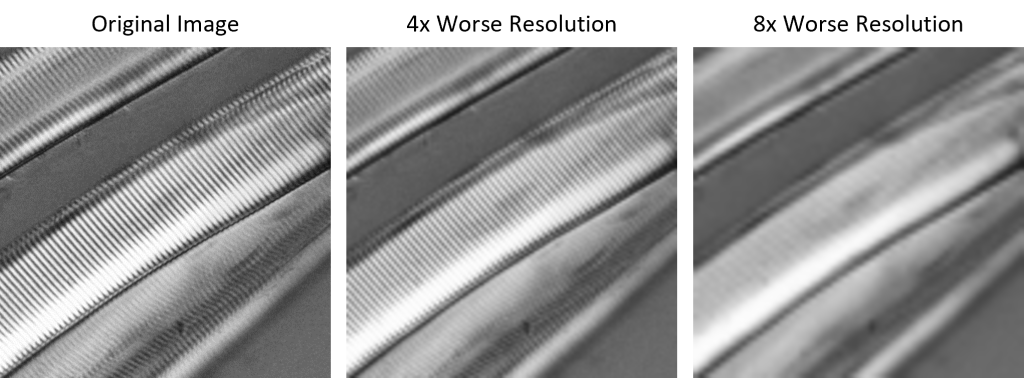2 Resolution, Magnification, and Size
Resolution
Resolution is the level of detail that you can see in an image. We commonly encounter this concept in relation to the resolution of our TVs, smart-phones, photos, and videos, and it is the same idea with the images generated by microscopes. We can think of resolution in terms of image quality, but if our ultimate goal is quantifying some aspect of our images (e.g. counting cells, measuring sizes), then we can also think about resolution as…
- How close two objects can be and still be distinguished, i.e. before they bleed-together into one object. In Fig. 1, you can clearly see the striations along the muscle fibers in the original image. With the resolution reduced 4x, you can still see the striations, but they are not as clear as in the original image. Reducing the resolution 8x renders the striations indistinguishable from each other; however the resolution of this image is still sufficient to distinguish the much larger individual muscle fibers. In the 8x image, the striations are below the resolution limit but the individual muscle fibers aren’t.
- How precisely you can measure the size of a small object. Although the striations can be resolved in both the original and 4x-lower images, the spacing between the striations can be more precisely measured from the original, high-resolution image. The striations are “fuzzier” in the 4x-lower image, which leads to uncertainty in the location of the striation edges.

If we were simply trying to distinguish the large muscle fibers, the lowest resolution image would be sufficient. However, if we needed to identify the individual striations along each fiber, we would need the highest-resolution image. How do you determine what level of resolution you need, and how do you know the resolution of your microscope system? In digital microscopy, there are two parameters that determine your overall image resolution: the optical resolution of the microscope and the pixel size. You are limited by whichever resolution is worse.
Optical Resolution
Optical Resolution is determined primarily by the objective numerical aperture (NA) and the wavelengths of light collected by the camera/detector. The NA is a measure of how well the objective collects light. Note that optical resolution does not depend on magnification! If you are performing a transmitted light technique (brightfield, phase contrast, DIC), it also depends on the condenser’s NA; if you are performing confocal microscopy, it also depends on the pinhole size. Approximate resolution limits are posted for every objective on the information sheet next to every microscope. They are just estimates because they were calculated for 500 nm light (blue/green), which may be different than the color of your specimen. Your optical resolution limit needs to smaller than the smallest object or distance you want to resolve. For example, our best objectives have a resolution limit of ~0.2 μm (200 nm). This means that if two objects are closer than 0.2 μm, they will appear as one object rather than two. If an object is smaller than 0.2 μm in diameter, we cannot determine its size; all we know is that it is smaller than 0.2 μm.
Digital Resolution (Pixel Size)
Digital resolution is determined by an image’s pixel size. These sizes are posted on the information sheet next to every microscope. They are determined by both the objective magnification and the camera, so you will see different sizes listed for each configuration. Your pixel size needs to be less than or equal to one third the size of the smallest object or distance that you want to resolve. Most of the microscopes in the facility are configured so that the pixel size is optimized for the optical resolution. The confocal microscope is different because 1) there are multiple ways to change the pixel size and, 2) the calculation for optimal pixel size is more complicated. Recommended pixel sizes are posted next to the confocal and you will be shown during your training how to determine the best pixel sizes for your specific experiment.
Example
Communicating and Understanding Size and Resolution
Communicating Size and Resolution
When you present an image, you must include a scalebar to give your audience a size reference for the objects in the image. Reporting the magnification is unhelpful because it is difficult for the viewer to interpret.
It’s also important for your audience to know the resolution of your images so they can evaluate the validity of your results. At a minimum, you need to report the pixel size and the objective’s NA and magnification.
Understanding Size at the Microscale
As you can see from the previous section, it is very valuable for microscopists to understand sizes at the microscale. Explore this interactive demonstration to get a feel for how different small biological objects compare to each other in terms of size (you don’t need to read the “notes” section): http://learn.genetics.utah.edu/content/cells/scale/.

